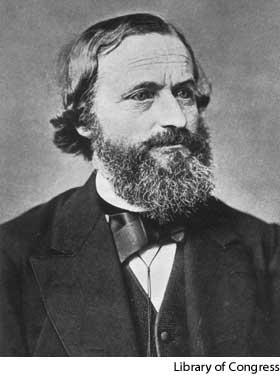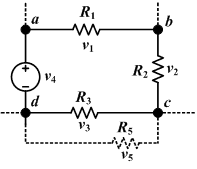Difference between revisions of "Gustav Kirchhoff" - New World Encyclopedia
| Line 1: | Line 1: | ||
| + | {{Claimed}} | ||
{{Infobox_Scientist | {{Infobox_Scientist | ||
| name = Gustav Robert Kirchhoff | | name = Gustav Robert Kirchhoff | ||
| Line 22: | Line 23: | ||
}} | }} | ||
| − | |||
'''Gustav Robert Kirchhoff''' (March 12, 1824 – October 17, 1887) was a [[Germany|German]] [[physicist]] who contributed to the fundamental understanding of [[electrical circuit]]s, [[spectroscopy]], and the emission of [[black-body]] radiation by heated objects. He coined the term "black body" radiation in 1862, and two sets of independent concepts in both circuit theory and thermal emission are named "[[Kirchhoff's laws]]" after him. | '''Gustav Robert Kirchhoff''' (March 12, 1824 – October 17, 1887) was a [[Germany|German]] [[physicist]] who contributed to the fundamental understanding of [[electrical circuit]]s, [[spectroscopy]], and the emission of [[black-body]] radiation by heated objects. He coined the term "black body" radiation in 1862, and two sets of independent concepts in both circuit theory and thermal emission are named "[[Kirchhoff's laws]]" after him. | ||
| Line 30: | Line 30: | ||
In 1862 he was awarded the [[Rumford Medal]] for his researches on the fixed lines of the solar spectrum, and on the inversion of the bright lines in the spectra of artificial light. | In 1862 he was awarded the [[Rumford Medal]] for his researches on the fixed lines of the solar spectrum, and on the inversion of the bright lines in the spectra of artificial light. | ||
| + | |||
| + | Kirchhoff died in 1887, and was buried in the St Matthäus Kirchhof Cemetery in [[Schöneberg]], [[Berlin]], only a few meters from the graves of the [[Brothers Grimm]]. | ||
| + | |||
| + | == Spectroscopy research == | ||
He contributed greatly to the field of spectroscopy by formalizing three laws that describe the [[optical spectrum|spectral]] composition of [[light]] emitted by incandescent objects, building substantially on the discoveries of [[David Alter]] and [[Anders Jonas Angstrom]] (see also: [[spectrum analysis]]) | He contributed greatly to the field of spectroscopy by formalizing three laws that describe the [[optical spectrum|spectral]] composition of [[light]] emitted by incandescent objects, building substantially on the discoveries of [[David Alter]] and [[Anders Jonas Angstrom]] (see also: [[spectrum analysis]]) | ||
| Line 39: | Line 43: | ||
#A hot solid object surrounded by a cool tenuous gas (i.e. cooler than the hot object) produces light with an almost continuous spectrum which has gaps at discrete wavelengths depending on the energy levels of the atoms in the gas. (''See also:'' [[absorption spectrum]]) | #A hot solid object surrounded by a cool tenuous gas (i.e. cooler than the hot object) produces light with an almost continuous spectrum which has gaps at discrete wavelengths depending on the energy levels of the atoms in the gas. (''See also:'' [[absorption spectrum]]) | ||
| + | The existence of these discrete lines was later explained by the [[Bohr model]], which helped lead to the development of [[quantum mechanics]]. | ||
| + | |||
| + | == Circuit Laws == | ||
| + | [[Image:KCL.png|framed|The current entering any junction is equal to the current leaving that junction. ''i''<sub>1</sub> + ''i''<sub>4</sub> = ''i''<sub>2</sub> + ''i''<sub>3</sub>]] | ||
| + | [[Image:KVL.png|framed|The sum of all the voltages around the loop is equal to zero. v<sub>1</sub> + v<sub>2</sub> + v<sub>3</sub> + v<sub>4</sub> = 0]] | ||
| + | |||
| + | '''Kirchhoff's circuit laws''' (or circuit rules) are a pair of laws that deal with the [[Charge conservation|conservation of charge]] and energy in [[electrical circuit]]s, and were first described in [[1845]] by [[Gustav Kirchhoff]]. Widely used in [[electrical engineering]], they are also called Kirchhoff's ''rules'' or simply Kirchhoff's ''laws''. | ||
| + | |||
| + | === Kirchhoff's Current Law (KCL)=== | ||
| − | The | + | The current law is also called '''Kirchhoff's first law''', '''Kirchhoff's point rule''', '''Kirchhoff's junction rule''', and '''Kirchhoff's first rule'''. It is based on the principle of conservation of [[electric charge]], which implies that: |
| + | :At any point in an [[electrical circuit]] where [[charge density]] is not changing in time, the sum of [[current (electricity)|current]]s flowing toward that point is equal to the sum of currents flowing away from that point. | ||
| + | |||
| + | === Kirchhoff's Voltage Law (KVL) === | ||
| − | Kirchhoff | + | The voltage law is also called '''Kirchhoff's second law''', '''Kirchhoff's loop rule''', and '''Kirchhoff's second rule'''. It is a consequence of the principle of [[conservation of energy]], which implies that: |
| + | :The directed sum of the electrical [[potential difference]]s around a circuit must be zero. | ||
==See also== | ==See also== | ||
| − | + | ||
* [[Kirchhoff equations]] | * [[Kirchhoff equations]] | ||
| − | * [[ | + | * [[Spectroscopy]] |
* [[Spectrum analysis]] | * [[Spectrum analysis]] | ||
== References == | == References == | ||
| + | <<These references, or whichever ones we use here, need to be formatted according to the "Author, Date" style indicated in the Writer's Manual. Also, please insert the ISBN numbers for all books. These numbers can be retrieved from Amazon.com. For examples of formatting references, see the References section of other bios.>> | ||
| + | |||
* [http://chem.ch.huji.ac.il/~eugeniik/history/kirchhoff.htm Short biography] | * [http://chem.ch.huji.ac.il/~eugeniik/history/kirchhoff.htm Short biography] | ||
* {{MacTutor Biography|id=Kirchhoff}} | * {{MacTutor Biography|id=Kirchhoff}} | ||
Revision as of 00:35, 28 March 2007
|
Gustav Robert Kirchhoff | |
|---|---|
 Gustav Kirchhoff | |
| Born |
12 March, 1824 |
| Died | 17 October, 1887 |
| Residence | |
| Nationality | |
| Field | Physicist |
| Institutions | University of Berlin University of Breslau University of Heidelberg |
| Alma mater | University of Königsberg |
| Academic advisor | Franz Ernst Neumann |
| Notable students | Max Noether Ernst Schröder |
| Known for | Kirchhoff's circuit laws Kirchhoff's law of thermal radiation |
| Notable prizes | Rumford medal |
Gustav Robert Kirchhoff (March 12, 1824 – October 17, 1887) was a German physicist who contributed to the fundamental understanding of electrical circuits, spectroscopy, and the emission of black-body radiation by heated objects. He coined the term "black body" radiation in 1862, and two sets of independent concepts in both circuit theory and thermal emission are named "Kirchhoff's laws" after him.
Gustav Kirchhoff was born in Königsberg, East Prussia, the son of Friedrich Kirchhoff, a lawyer, and Johanna Henriette Wittke. He graduated from the Albertus University of Königsberg in 1847 where he attended the mathematico-physical seminar directed by Franz Ernst Neumann and Friedrich Julius Richelot. He married Clara Richelot, the daughter of his mathematics professor Richelot. In the same year, they moved to Berlin, where he stayed until he received a professorship at Breslau.
Kirchhoff formulated his circuit laws, which are now ubiquitous in electrical engineering, in 1845, while still a student. He completed this study as a seminar exercise; it later became his doctoral dissertation. He proposed his law of thermal radiation in 1859, and gave a proof in 1861. He was called to the University of Heidelberg in 1854, where he collaborated in spectroscopic work with Robert Bunsen. Together Kirchhoff and Bunsen discovered caesium and rubidium in 1861 while studying the chemical composition of the Sun via its spectral signature. At Heidelberg he ran a mathematico-physical seminar, modelled on Neumann's, with the mathematician Leo Koenigsberger. Among those who attended this seminar were Arthur Schuster and Sofia Kovalevskaya. In 1875 Kirchhoff accepted the first chair specifically dedicated to theoretical physics at Berlin.
In 1862 he was awarded the Rumford Medal for his researches on the fixed lines of the solar spectrum, and on the inversion of the bright lines in the spectra of artificial light.
Kirchhoff died in 1887, and was buried in the St Matthäus Kirchhof Cemetery in Schöneberg, Berlin, only a few meters from the graves of the Brothers Grimm.
Spectroscopy research
He contributed greatly to the field of spectroscopy by formalizing three laws that describe the spectral composition of light emitted by incandescent objects, building substantially on the discoveries of David Alter and Anders Jonas Angstrom (see also: spectrum analysis)
Kirchhoff's Three Laws of Spectroscopy:
- A hot solid object produces light with a continuous spectrum.
- A hot tenuous gas produces light with spectral lines at discrete wavelengths (i.e. specific colors) which depend on the energy levels of the atoms in the gas. (See also: emission spectrum)
- A hot solid object surrounded by a cool tenuous gas (i.e. cooler than the hot object) produces light with an almost continuous spectrum which has gaps at discrete wavelengths depending on the energy levels of the atoms in the gas. (See also: absorption spectrum)
The existence of these discrete lines was later explained by the Bohr model, which helped lead to the development of quantum mechanics.
Circuit Laws
Kirchhoff's circuit laws (or circuit rules) are a pair of laws that deal with the conservation of charge and energy in electrical circuits, and were first described in 1845 by Gustav Kirchhoff. Widely used in electrical engineering, they are also called Kirchhoff's rules or simply Kirchhoff's laws.
Kirchhoff's Current Law (KCL)
The current law is also called Kirchhoff's first law, Kirchhoff's point rule, Kirchhoff's junction rule, and Kirchhoff's first rule. It is based on the principle of conservation of electric charge, which implies that:
- At any point in an electrical circuit where charge density is not changing in time, the sum of currents flowing toward that point is equal to the sum of currents flowing away from that point.
Kirchhoff's Voltage Law (KVL)
The voltage law is also called Kirchhoff's second law, Kirchhoff's loop rule, and Kirchhoff's second rule. It is a consequence of the principle of conservation of energy, which implies that:
- The directed sum of the electrical potential differences around a circuit must be zero.
See also
- Kirchhoff equations
- Spectroscopy
- Spectrum analysis
ReferencesISBN links support NWE through referral fees
<<These references, or whichever ones we use here, need to be formatted according to the "Author, Date" style indicated in the Writer's Manual. Also, please insert the ISBN numbers for all books. These numbers can be retrieved from Amazon.com. For examples of formatting references, see the References section of other bios.>>
- Short biography
- John J. O'Connor and Edmund F. Robertson. Gustav Kirchhoff at the MacTutor archive
- Eric W. Weisstein, Kirchhoff, Gustav (1824-1887) at ScienceWorld.
| Persondata | |
|---|---|
| NAME | Kirchhoff, Gustav Robert |
| ALTERNATIVE NAMES | |
| SHORT DESCRIPTION | Physicist |
| DATE OF BIRTH | 12 March, 1824 |
| PLACE OF BIRTH | Königsberg, East Prussia |
| DATE OF DEATH | 17 October, 1887 |
| PLACE OF DEATH | Berlin, Germany |
Credits
New World Encyclopedia writers and editors rewrote and completed the Wikipedia article in accordance with New World Encyclopedia standards. This article abides by terms of the Creative Commons CC-by-sa 3.0 License (CC-by-sa), which may be used and disseminated with proper attribution. Credit is due under the terms of this license that can reference both the New World Encyclopedia contributors and the selfless volunteer contributors of the Wikimedia Foundation. To cite this article click here for a list of acceptable citing formats.The history of earlier contributions by wikipedians is accessible to researchers here:
The history of this article since it was imported to New World Encyclopedia:
Note: Some restrictions may apply to use of individual images which are separately licensed.

